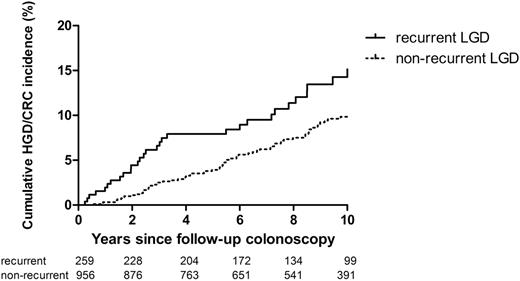-
Views
-
Cite
Cite
M de Jong, H Kanne, L Nissen, I Nagtegaal, J Drenth, L Derikx, F Hoentjen, DOP72 Increased risk of advanced neoplasia in inflammatory bowel disease patients with recurrent low-grade dysplasia, Journal of Crohn's and Colitis, Volume 13, Issue Supplement_1, March 2019, Pages S073–S074, https://doi.org/10.1093/ecco-jcc/jjy222.106
Close - Share Icon Share
Abstract
A history of low-grade dysplasia (LGD) is a major risk factor for the development of high-grade dysplasia (HGD) and colorectal cancer (CRC) in inflammatory bowel disease (IBD) patients. Consequently, guidelines recommend an intensified surveillance programme for these patients. However, it is unknown how a second (recurrent) LGD impacts advanced neoplasia (HGD and/or CRC) risk. We aimed to assess the long-term advanced neoplasia risk in IBD patients with recurrent LGD and compared this to patients without subsequent dysplasia after initial LGD.
We identified all IBD patients with LGD from 1991 to 2005 in The Netherlands who received at least one follow-up colonoscopy in the subsequent 3 years, using the Dutch nationwide network and registry of histo- and cytopathology in the Netherlands (PALGA). Follow-up data were collected until 2016. Kaplan–Meier curves were used to compare the cumulative advanced neoplasia incidence between patients with and without recurrent LGD at first colonoscopy after initial LGD. Patients were censored at the end of surveillance or colectomy.
We identified 1215 IBD patients with colonic LGD and follow-up colonoscopy within 3 years (923 (76.0%) ulcerative colitis, 214 (17.6%) Crohn’s disease, and 78 (6.4%) IBD unclassified). Mean time from initial LGD to first follow-up colonoscopy was 1.5 (±0.6) years in both patients with and without recurrent LGD. A total of 259 patients (21.3%) had recurrent LGD within 3 years, of whom 46 patients (17.8%, 31 CRC and 15 HGD) developed advanced neoplasia (vs. 10.9% in patients without recurrent LGD). Patients with recurrent LGD had a higher cumulative advanced neoplasia incidence (HR 1.70; 95% CI 1.20–2.41; p = 0.003; Figure 1). The cumulative advanced neoplasia incidence 2 years after follow-up surveillance colonoscopy was 4.4% in patients with dysplasia, vs. 1.4% in those without recurrent dysplasia.

Kaplan–Meier plot showing the cumulative advanced neoplasia incidence following first follow-up colonoscopy within 3 years after initial LGD, plotted separately for patients with and without recurrent LGD at follow-up colonoscopy.
Recurrent LGD at follow-up colonoscopy after initial LGD increased the advanced neoplasia risk (HR 1.70). Patients without LGD at follow-up colonoscopy after initial LGD had a cumulative advanced neoplasia incidence of 1.4% in the subsequent 2 years.





